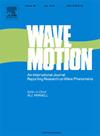Acoustic axes conditions revised
IF 2.5
3区 物理与天体物理
Q2 ACOUSTICS
引用次数: 0
Abstract
The explanation of the basic acoustic properties of crystals requires a recognition of the acoustic axes. To derive the acoustic axes in a given material, one requires both a workable method and the necessary and sufficient criteria for the existence of the acoustic axes in a partial propagation direction. This paper’s primary input is an alternate minimal polynomial-based system of acoustic axes conditions. In this approach, we derive a novel additional characteristic of acoustic axes: the directions in which the minimal polynomial of the third order is reduced to that of the second order. Next, we offer a general solution, that utilizes a scalar and a unit vector for defining the acoustic tensor along the acoustic axis. It is shown that the scalar matches the eigenvalue of the reduced acoustic tensor, and the vector corresponds to the polarization into the single eigenvalue direction. We use the minimal polynomial construction to demonstrate the equivalence of different acoustic axis criteria. We demonstrate the applicability of this approach to actual computations of the acoustic axes and their fundamental properties (phase speeds and polarizations) for high symmetry cases, such as isotropic materials and RTHC crystals.
修正的声轴条件
要解释晶体的基本声学特性,就必须认识声轴。为了推导给定材料中的声轴,既需要一种可行的方法,又需要在部分传播方向上存在声轴的必要和充分的准则。本文的主要输入是一个基于交替最小多项式的声轴条件系统。在这种方法中,我们导出了声轴的一个新的附加特征:三阶最小多项式降为二阶最小多项式的方向。接下来,我们提供了一个通用的解决方案,它利用一个标量和一个单位向量来定义沿着声学轴的声学张量。结果表明,标量与约简声张量的特征值相匹配,矢量对应于单特征值方向的极化。我们用最小多项式构造证明了不同声轴准则的等价性。我们证明了这种方法在高对称性情况下(如各向同性材料和RTHC晶体)声轴及其基本特性(相速度和极化)的实际计算中的适用性。
本文章由计算机程序翻译,如有差异,请以英文原文为准。
求助全文
约1分钟内获得全文
求助全文
来源期刊

Wave Motion
物理-力学
CiteScore
4.10
自引率
8.30%
发文量
118
审稿时长
3 months
期刊介绍:
Wave Motion is devoted to the cross fertilization of ideas, and to stimulating interaction between workers in various research areas in which wave propagation phenomena play a dominant role. The description and analysis of wave propagation phenomena provides a unifying thread connecting diverse areas of engineering and the physical sciences such as acoustics, optics, geophysics, seismology, electromagnetic theory, solid and fluid mechanics.
The journal publishes papers on analytical, numerical and experimental methods. Papers that address fundamentally new topics in wave phenomena or develop wave propagation methods for solving direct and inverse problems are of interest to the journal.
 求助内容:
求助内容: 应助结果提醒方式:
应助结果提醒方式:


